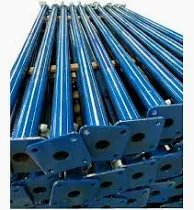أغسطس . 19, 2024 20:53 Back to list
Exploring Innovative Techniques in Flexible Formwork for Sustainable Construction in China
The Evolution of China’s Flexible Formwork System
In recent years, the construction industry has witnessed a significant transformation, particularly in China, where innovative building methods are gaining ground. One such advancement is the use of flexible formwork systems, which have emerged as a practical and efficient solution for achieving complex geometries in concrete structures. This article explores the development, advantages, and future potential of flexible formwork systems in China.
Flexible formwork is a construction technique that uses adaptable, lightweight materials to mold concrete into various shapes. Unlike traditional rigid formwork, which typically uses wooden or steel panels, flexible formwork can easily conform to intricate designs and curves. This adaptability makes it particularly appealing in contemporary architecture, where creativity and unique designs are highly valued.
The Evolution of China’s Flexible Formwork System
One of the primary advantages of flexible formwork is its ability to reduce labor and material costs. Traditional formwork can be labor-intensive and time-consuming to install and remove. In contrast, flexible formwork can be deployed more rapidly, minimizing the time spent on construction and allowing for quicker completion of projects. Additionally, the materials used in flexible systems tend to be lighter and easier to handle, further expediting the construction process.
china flexible formwork

Sustainability is another critical factor driving the adoption of flexible formwork in China. The construction industry has been scrutinized for its environmental impact, and builders are increasingly seeking ways to reduce waste and energy consumption. Flexible formwork systems can significantly lower the volume of concrete used in projects since they enable better control of material placement. Furthermore, many flexible formwork options are reusable, decreasing the need for new materials and reducing the overall environmental footprint of construction activities.
Integration of modern technology with flexible formwork is another exciting area of development. Advancements in digital modeling and fabrication techniques allow architects and engineers to design highly complex forms that can be easily translated into physical structures. In this context, flexible formwork serves as an bridge between innovative design and practical construction, enabling unique architectural visions to come to life.
Looking forward, the future of flexible formwork systems in China appears promising. As more architects and builders continue to experiment with creative designs, the demand for versatile and adaptable construction solutions is expected to grow. Furthermore, ongoing research and development aimed at improving the materials and methods associated with flexible formwork will likely enhance its performance and applications across various types of projects.
In conclusion, China’s embrace of flexible formwork technology is indicative of a larger trend toward innovation within the construction industry. By fostering creativity, sustainability, and efficiency, flexible formwork represents a vital tool in addressing the challenges posed by urbanization and architectural demands. As the industry continues to evolve, it is apparent that flexible formwork will play a crucial role in shaping the future of concrete construction in China and beyond.
-
OEM Column Formwork: Circular, Curved & Inclined Solutions
NewsAug.26,2025
-
Premium Scaffolding Jacks: Stable, Adjustable & Durable
NewsAug.25,2025
-
OEM Wall Formwork & Shuttering: Flexible & Curved Solutions
NewsAug.24,2025
-
Adjustable Heavy Duty Props for Slab Formwork | Strong & Reliable Support
NewsAug.23,2025
-
Adjustable Heavy Duty Props for Slab Formwork - Strong & Safe Support
NewsAug.22,2025
-
Formwork Spring Clamp Factories: Quality & Bulk Supply
NewsAug.21,2025